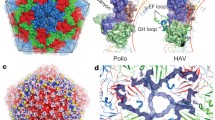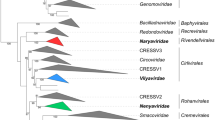Abstract
Glutathione peroxidase (GPx) is the prototypical eukaryotic selenoprotein, with the rare amino acid selenocysteine (Sec) at the enzyme active site, encoded by the UGA codon in RNA. A DNA virus,Molluscum contagiosum, has now been shown to encode a functional selenium-dependent GPx enzyme. Using modifications of conventional sequence database searching techniques to locate potential viral GPx modules, combined with structurally guided comparative sequence analysis, we provide compelling evidence that Se-dependent GPx modules are encoded in a number of RNA viruses, including potentially serious human pathogens like HIV-1 and hepatitis C virus, coxsackievirus B3, HIV-2, and measles virus. Analysis of the sequences of multiple viral isolates reveals conservation of the putative GPx-related features, at least within viral subtypes or genotypes, supporting the hypothesis that these are functional GPx modules.
Similar content being viewed by others
References
R. A. Sunde, Selenium, inHandbook of Nutritionally Essential Minerals, B. L. O’Dell and R. A. Sunde, eds., Marcel Dekker, New York, pp. 493–556 (1997).
R. J. Turner and J. M. Finch, Selenium and the immune response,Proc. Nutr. Soc. 50, 275–285 (1991).
E. W. Taylor, Selenium and viral diseases: facts and hypotheses,J. Orthomol. Med. 12, 227–239 (1997).
T. M. Buttke and P. A. Sandstrom, Redox regulation of programmed cell death in lymphocytes,Free Radical Res. 22, 389–397 (1994).
M. Roy, L. Kiremidjian-Schumacher, H. I. Wishe, M. W. Cohen, and G. Stotzky, Supplementation with selenium and human immune cell functions. I. Effect on lymphocyte proliferation and interleukin 2 receptor expression.Biol. Trace Element Res. 41, 103–114 (1994).
E. W. Taylor, R. G. Nadimpalli, and C. S. Ramanathan, Genomic structures of viral agents in relation to the biosynthesis of selenoproteins,Biol. Trace Element Res. 56, 63–91 (1997).
M. J. Berry, G. W. Martin III, and S. C. Low, RNA and protein requirements for eukaryotic selenoprotein synthesis,Biomed. Environ. Sci. 10, 182–189 (1997).
M. J. Berry and P. R. Larsen, Recognition of UGA as a selenocysteine codon in eukaryotes: a review of recent progress,Biochem. Soc. Trans. 21, 827–832 (1993).
A. Bock, K. Forchhammer, J. Heider, W. Leinfelder, G. Sawers, B. Veprek, et al., Selenocysteine: the 21st amino acid,Mol. Microbiol. 5, 515–520 (1991).
E. W. Taylor, C. S. Ramanathan, R. K. Jalluri, and R. G. Nadimpalli, A basis for new approaches to the chemotherapy of AIDS: novel genes in HIV-1 potentially encode selenoproteins expressed by ribosomal frameshifting and termination suppression,J. Med. Chem. 37, 2637–2654 (1994).
E. W. Taylor, C. S. Ramanathan, and R. G. Nadimpalli, A general method for predicting new genes in nucleic acid sequences: application to the human immunodeficiency virus, inComputational Medicine, Public Health and Biotechnology, Ser. Math. Biolo. Med.5, 285–309, M. Witten, ed., World Scientific, Singapore, (1996).
C. S. Ramanathan and E. W. Taylor, Computational genomic analysis of hemorrhagic fever viruses: viral selenoproteins as a potential factor in pathogenesis,Biol. Trace Element Res. 56, 93–106 (1997).
J. Bai, S. Wu, K. Ge, X. Deng, and C. Su, The combined effect of selenium deficiency and viral infection on the myocardium of mice,Acta Acad. Med. Sin. 2, 29–31 (1980).
M. A. Beck, P. C. Kolbeck, L. H. Rohr, Q. Shi, V. C. Morris, and O. A. Levander, Benign human enterovirus becomes virulent in selenium-deficient mice,J. Med. Virol. 43, 166–170 (1994).
M. A. Beck, Q. Shi, V. C. Morris, and O. A. Levander, Rapid genomic evoluton of a non-virulent Coxsackievirus B3 in selenium-deficient mice results in selection of identical virulent isolates,Nature Med. 1, 433–436 (1995).
T. G. Senkevich, J. J. Bugert, J. R. Sisler, E. V. Koonin, G. Darai, and B. Moss, Genome sequence of a human tumorigenic poxvirus: prediction of specific host responseevasion genes,Science 273, 813–816 (1996).
J. L. Shisler, T. G. Senkevich, M. J. Berry, and B. Moss, Ultraviolet-induced cell death blocked by a selenoprotein from a human dermatotropic poxvirus,Science 279, 102–105 (1998).
E. W. Taylor, A. Bhat, R. G. Nadimpalli, W. Zhang, and J. D. Kececioglu, HIV-1 encodes a sequence overlapping env gp41 with highly significant similarity to selenium-dependent glutathione peroxidases,J. AIDS Hum. Retrovirol. 15, 393–394 (1997).
O. Epp, R. Ladenstein, and A. Wendel, The refined structure of the selenoenzyme glutathione peroxidase at 0.2 nm resolution,Eur. J. Biochem. 133, 51–69 (1983).
K. D. Aumann, N. Bedorf, R. Brigelius-Flohe, D. Schomburg, and L. Flohe, Glutathione peroxidase revisited-simulation of the catalytic cycle by computer-assisted molecular modelling,Biomed. Environ. Sci. 10, 136–155 (1997).
W. Zhang, J. D. Kececioglu, and E. W. Taylor, Assessing distant homology between an aligned protein family and a proposed member through accurate sequence alignment,J. Mol. Evol., submitted.
L. Zhao, J. A. Ruzicka, A. G. Cox, and E. W. Taylor, HIV-1 encodes a sequence with functional glutathione peroxidase activity: implications for the link between selenium deficiency and AIDS, presented at the4th Dresden Selenium Symposium, Dresden, Germany, May 15–16, 1999.
V. N. Gladyshev, T. C. Stadtman, D. L. Hatfield, and K.-T. Jeang, Levels of major selenoproteins in T cells decrease during HIV infection and low molecular mass selenium compounds increase,Proc. Natl. Acad. Sci. USA 96, 835–839 (1999).
E. W. Taylor, Defense of the HIV selenoprotein theory: a critique of Gladyshev et al. (1999) Posted at http://bioinfo.chem.uga.edu/homepage/wtaylor.
S. Vidal, J. Curran, and D. Kolakofsky, A stuttering model for paramyxovirus P mRNA editing,EMBO J. 9, 2017–2022 (1990).
S. M. H. Horikamin and S. A. Moyer, Synthesis of leader RNA and editing of the P mRNA during transcription by purified measles virus,J. Virol. 65, 5342–5347 (1991).
M. Steward, I. B. Vipond, N. S. Millar, and P. T. Emmerson, RNA editing in Newcastle disease virus,J. Gen. Virol. 74, 2539–2547 (1993).
M. Bjornstedt, S. Kumar, L. Bjorkhem, G. Spyrou, and A. Holmgren, Selenium and the thioredoxin and glutaredoxin systems,Biomed. Environ. Sci. 10, 271–279 (1997).
C. Sappey, S. Legrand-Poels, M. Best-Belpomme, A. Favier, B. Rentier, and J. Piette, Stimulation of glutathione peroxidase activity decreases HIV Type 1 activation after oxidative stress,AIDS Res. Hum. Retrovir. 10, 1451–1461 (1994).
K. Hori, D. Hatfield, F. Maldarelli, B. J. Lee, and K. A. Clouse, Selenium supplementation suppresses tumor necrosis factor α-induced human immunodeficiency virus type 1 replication in vitro,AIDS Res. Hum. Retrovir. 13, 1325–1332 (1997).
P. A. Sandstrom, J. Murray, T. M. Folks, and A. M. Diamond, Antioxidant defenses influence HIV-1 replication and associated cytopathic effects,Free Radical Biol. Med. 24, 1485–1491 (1998).
E. W. Taylor, A. G. Cox, L. Zhao, J. A. Ruzicka, A. Bhat, W. Zhang, et al., Nutrition, HIV and drug abuse: the molecular basis of a unique role for selenium,J. AIDS Human Retrovir., in press.
J. Constans, J. L. Pellegrin, C. Sergeant, M. Simonoff, I. Pellegrin, H. Fleury, et al., Serum selenium predicts outcome in HIV infection,J. AIDS 10, 392 (1995).
M. P. Look, J. K. Rockstroh, G. S. Rao, K. A. Kreuzer, S. Barton, H. Lemoch, et al., Serum selenium, plasma glutathione (GSH) and erythrocyte glutathione peroxidase (GSH-Px)-levels in asymptomatic versus symptomatic human immunodeficiency virus-1 (HlV-l)-infection,Eur. J. Clin. Nutr. 51, 266–272 (1997).
M. K. Baum, G. Shor-Posner, S. Lai, G. Zhang, H. Lai, M. A. Fletcher, et al., High risk of mortality in HIV infection is associated with selenium deficiency,J. AIDS Hum. Retrovir. 15, 370–374 (1997).
Author information
Authors and Affiliations
Rights and permissions
About this article
Cite this article
Zhang, W., Ramanathan, C.S., Nadimpalli, R.G. et al. Selenium-dependent glutathione peroxidase modules encoded by RNA viruses. Biol Trace Elem Res 70, 97–116 (1999). https://doi.org/10.1007/BF02783852
Received:
Revised:
Accepted:
Issue Date:
DOI: https://doi.org/10.1007/BF02783852




